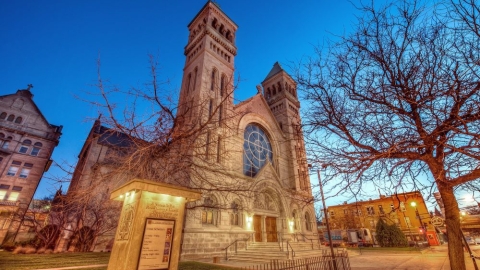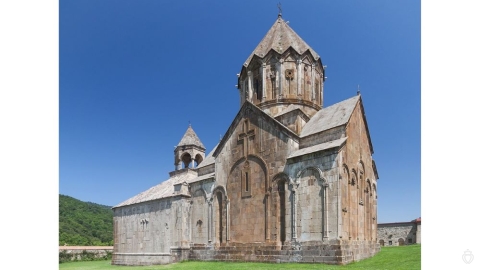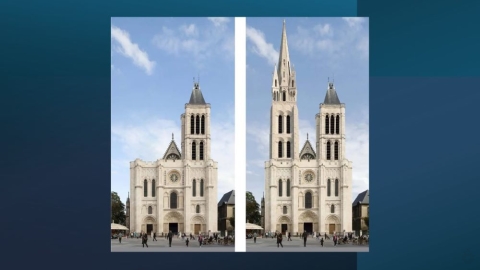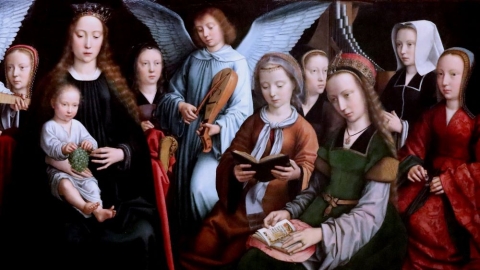Presentation of the Blessed Virgin Mary

Presentation of the Virgin in the Temple, Vittore Carpaccio, Pinacoteca di Brera
The story of the Presentation of Mary in the Temple has come down to us through the apocryphal gospels, notably through the Proto-Gospel of James (where it deals with the birth of the Virgin and Christ) and through the gospel of Pseudo-Matthew, which is 7th century text based on it). Additionally, testimonies and oral tradition also shape our understanding of the event.
A divine messenger, the Angel of the Lord, appears first to Joachim to announce to him the conception and future birth of Mary despite the advanced age of her mother, Anne. The angel indicates to Anne that when the child has reached her third birthday, the little girl must be taken to the Temple to serve the Lord day and night with fasting and prayer.
Thus it was a young child who would climb the 15 steps of the Temple (according to Psalms 119 to 133, known as “Songs of Ascents”). While her parents waited at the bottom of the steps dressed in festive clothes (as was customary), Mary climbed these steps alone, which was interpreted as a sign of the perfection of her soul. Once the sacrifice was accomplished and the vow was pronounced, Joachim and Anne return home alone. Mary was then raised among other young virgins until the age of 14.
***
First celebrated in the East beginning in the 6th century, this festival has its origins in Jerusalem: the date of November 21 corresponds to the dedication of the Basilica of Sainte-Marie-la-Neuve (the Nea) in 543. It was then celebrated in Constantinople in the 7th century. As is often the case, Providence would then use a human instrument to advance the divine plan.
A great traveler, mystic knight, and advisor to princes, Philippe de Mézières, chancellor of the King of Cyprus, took advantage of a stay in Venice to plead in favor of celebrating the feast of the Presentation of Mary in the Temple in 1369. He was indignant that it was observed in the East and not in the West, because of its importance in the life of the Blessed Virgin. For him, it was a matter of singing new praises to Mary and obtaining her intercession.
His enterprise was quickly crowned with success because, starting in 1369, the festival was celebrated in Venice. Two years later, to the great joy of this knight, it was officially adopted by the Franciscan circles of the city, probably because of their great Marian devotion.
Philippe de Mézières’s actions continued in Avignon in 1372 as part of a diplomatic mission for the King of Cyprus. He convinced Gregory XI to promote this celebration. Cautiously, the Sovereign Pontiff tolerated it, preferring not to approve it too quickly.
Nine cardinals out of 28, as well as numerous religious figures and a large number of faithful, attended the Mass. It was a great success, which can also be interpreted as a desire for rapprochement with the Orthodox Greeks and to promote union between Christians. Philippe de Mézières was in fact an ardent activist for the crusade and the reconquest of the Holy Places, especially in the context of the Turkish threat to Europe.
Summoned by the King of France to advise him and take part in the education of the king's eldest son, Philippe de Mézières left Avignon for Paris. He quickly managed to win over Charles V to his cause and, on November 21, 1373, the Presentation of Mary was celebrated for the first time at Sainte-Chapelle. The spread of this celebration continued in Europe, thanks to joint action by the two men.
Finally formalized in 1585 under Pope Sixtus V, this feast of Our Lady is celebrated by the Catholic Church on November 21.
(Source : Chapelle de la Présentation de Marie du District de Suisse - FSSPX.Actualités)
Illustration : Flickr / Richard Mortel CC BY 2.0
Diaporama
Illustration 1 : Maître de la Vie de Marie, Cologne. Flickr / Jean Louis Mazieres CC BY-NC-SA 2.0
Illustration 2 : Giovanni Battista Cima da Conegliano, Dresde. Flickr / Jean Louis Mazieres CC BY-NC-SA 2.0
Illustration 3 : Giotto, Scrovegni. Giotto, Domaine public, via Wikimedia Commons
Illustration 4 : Jacopo Tintoretto, Domaine public, via Wikimedia Commons
Illustration 5 : Basilique Sainte-Marie, Krakow. Flickr / Fr Lawrence Lew OP CC BY-NC-ND 2.0
Illustration 6 : Le Titien, Venise. © José Luiz Bernardes Ribeiro, via Wikimedia Commons
Illustration 7 : Maître de la Vie de Marie, Londres. Flickr / Jean Louis Mazieres CC BY-NC-SA 2.0












